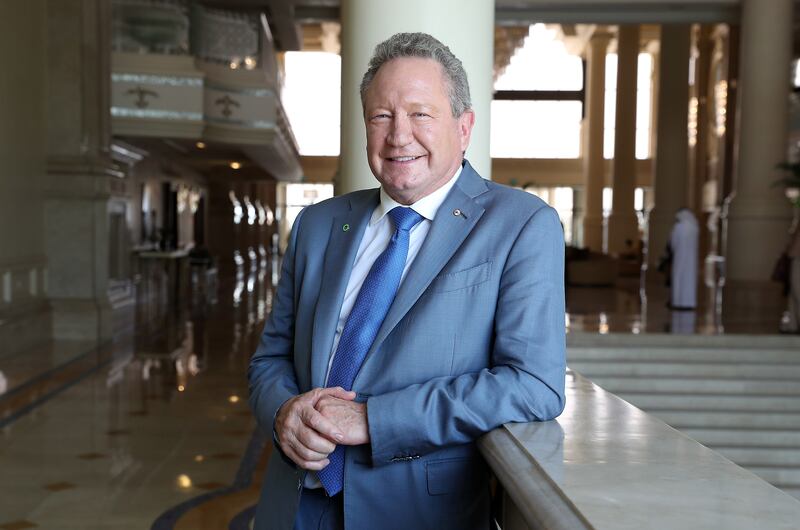Andrew “Twiggy” Forrest, Australia's second-richest man, is looking at opportunities for investment in green hydrogen in the Middle East, which he sees at the forefront of a green industrial revolution, amid the global effort to reach net zero by the middle of the century.
“We have invested in the best technology for the green industrial revolution in the world and we will be able to bring the leading-edge technology in the world, into the UAE and be able to demonstrate that these projects are highly commercial if they're built at scale today,” Mr Forrest said in an interview with The National in Abu Dhabi.
Mr Forrest, whose total net worth is estimated at $14 billion by Forbes, made his fortune in Australia's mining industry and currently heads Fortescue Future Industries, which invests in green hydrogen projects around the world.
Green hydrogen is being prioritised for development as an alternative clean fuel, amid growing efforts to decarbonise the global grid from fossil fuels. Australia, which is the world's 12th-biggest polluter, has ambitions to grow its green hydrogen capacity – with the government alone investing $1.2bn in the industry.
In the Middle East, which is the world's biggest exporter of crude, key oil-producing nations the UAE and Saudi Arabia have pledged to reach net zero by 2050 and 2060, respectively.
Both countries also have huge ambitions to develop hydrogen as a viable energy resource in a world that is gradually phasing out fossil fuels.
“There's very serious development potential here [the UAE]. It's a government that really understands the absolute necessity of the world going green. It understands that having very high-quality fossil fuels here when the sunset falls on fossil fuels, the last people standing will be those with the least polluting fuels,” Mr Forrest said.
While regional efforts have focused primarily on “blue hydrogen” – the low-carbon fuel produced through steam methane reformation, with the emitted carbon dioxide captured and sequestered – efforts to completely green the process are also under way.
“They will, of course, give way finally to completely green hydrogen, but they'll have a role to play in the transition,” Mr Forrest added.
Green hydrogen is produced through electrolysis using energy from the wind and sun to split molecules into hydrogen and oxygen.
While attending Cop26 in Glasgow, Mr Forrest committed to developing a 15 gigawatt green project in Argentina, which is estimated to cost around $8.4bn.
“We're selecting the best governments to work with. We see great radiance, great renewable energy here in solar,” he said.
“And that will compete wonderfully with hydro projects, as well as wind projects in Argentina, who have really strong dominance in a very high capacity factor – wind,” he added.
Around 131 hydrogen global projects have been announced since February, which require an estimated total investment of $500bn through to 2030, according to the Hydrogen Council, a global business-led initiative to develop the hydrogen economy.
Most of these projects are relatively small capacity and are state-funded or backed. However, Mr Forrest, who is a large private investor in the industry, sees the fuel already at a commercial stage and ripe for private investment.
“I can see it as commercial. We are already entering into agreements. I think hydrogen is commercial now,” Mr Forrest said.
“There's never been so much unallocated liquidity in our system. I certainly believe the capital will be there to develop projects which are ethical, protect the community, global human rights, and protect the environment [and also] is commercial, in that order of priority.
“If they meet those expectations, and I believe the capital will be there for these projects, which will send the world green,” he added.







